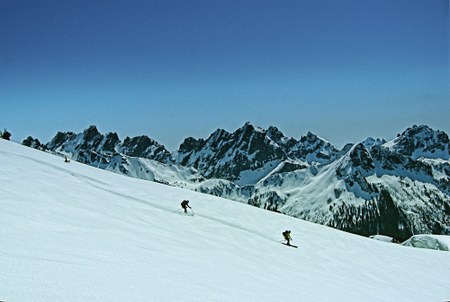
Squinting against the morning sun, I stab my pole into the steep east face of Wild Goat Peak and break loose a small snowball that quickly grows to the size of a man’s torso. Gaining speed as it travels downhill, the snowball finally topples where the mountain’s pitch shallows out. The test confirms my suspicions: this face is ripe for a wet avalanche.
Nervously, I survey the landscape ahead. Our route takes us across a few continuously steep pitches, all with cliff bands looming dangerously below. Every step out on the face will kick more snowballs, inevitably triggering a large slide. In all likelihood, the slide would run out below us, leaving us watching thousands of pounds of heavy snow cascading down the cliffs. But one slip and we could easily get caught and dragged down, too. All it would take is one snowball to fall off a rock or tree above and trigger a slide, and we would have no escape. I look back at my ski partner Tom. His face is telling me the same thing as Wild Goat Peak. Sometimes the dream isn’t worth a nightmare.
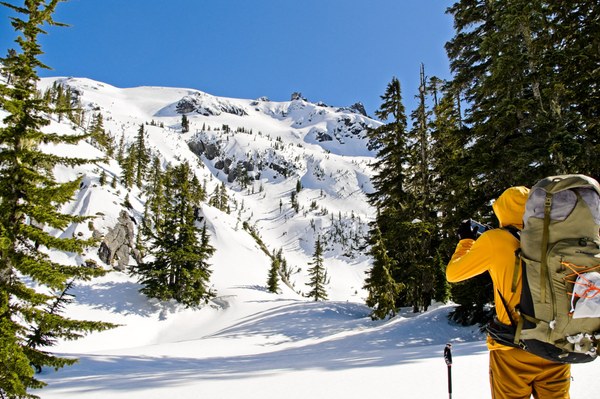 The North Slopes of Big Snow Mountain, a Pacific Northwest Masterpiece.
The North Slopes of Big Snow Mountain, a Pacific Northwest Masterpiece.
The plan
Five weeks ago, Kyle, Tom, and I had set our sights on the Snoqualmie Haute Route. Pioneered by Martin Volken in 2000 and named after the world-famous Haute Route in France and Switzerland, the route traverses the towering crest northeast of Snoqualmie Pass. I like to call it the “Snoqualmie Crest.” It’s made of jagged spires, sheer walls, and hanging glaciers. The peaks are so dense that they are named in groups. The Chiefs. The Chimneys. The Lemahs. They’re hard to see from any road, yet hard to miss from any peak.
I’ve spent years branching out from the ski area into the backcountry ski terrain around Snoqualmie Pass. With at least a full day approach from any direction, and surrounded by other worthy objectives, the Snoqualmie Haute Route explores a zone I have often seen and seldom visited. It’s my favorite part of the Cascades.
After a tumultuous early spring, we’re ecstatic when a high-pressure system develops, forecasting sunshine all five days. Unfortunately, the snowpack needs time to transition from winter to spring. Avalanche conditions can be dangerous as the snow warms until it settles from repeated freeze-thaw cycles. The forecast predicts an increase in temperature each day, and above freezing temperatures each night, meaning the snow would be continuously transitioning throughout the trip. We pack extra sunscreen and promise to be careful.
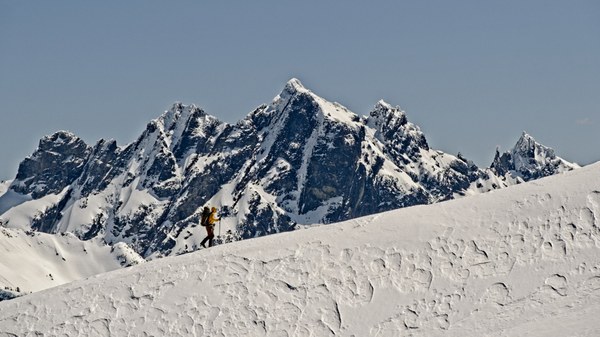 Tom among views of The Lemahs.
Tom among views of The Lemahs.
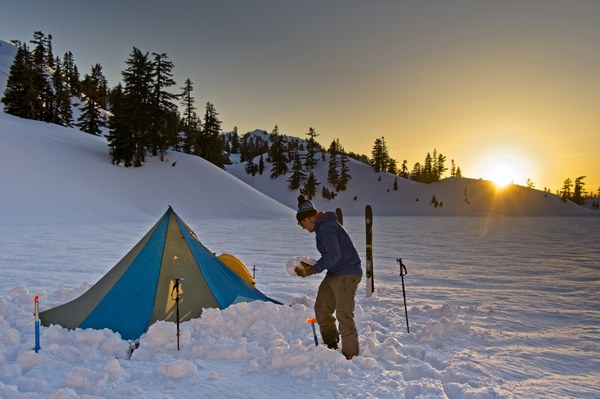 Kyle enjoying camp life.
Kyle enjoying camp life.
The pull
Our journey starts deep in the Middle Fork Snoqualmie drainage and slowly earns peekaboo views of the northwest face of our day’s summit objective: Big Snow Mountain. We have no plans to ski anything I can see so far, but my mind is trained to seek skiable lines. The northwest face is an easy one to read. It’s cut straight down the middle by a deep gully directly below an obvious weakness in the otherwise impassible cliffs guarding both sides. I name it “The Crack,” in a simplistic ode to the popular line “The Slot” on nearby Snoqualmie Mountain, take some pictures, and file it away in my ever-growing mental list of places I want to ski one day.
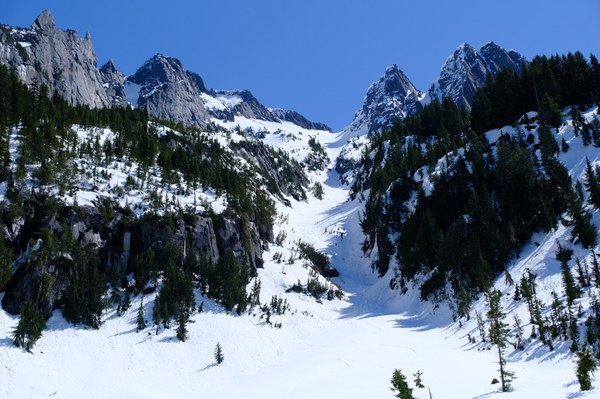 "The Crack," begging to be skied.
"The Crack," begging to be skied.
One steep boot pack and the character of the landscape drastically changes. We exit the forest and abruptly enter the subalpine. The broad and complex north face of Big Snow Mountain glistens before us – a Pacific Northwest masterpiece: two frozen lakes flanked by isolated rock towers, steep couloirs, wide open bowls, waterfalls, and ice flows. Unlike the obvious single line of the northwest face, the north face of Big Snow is a cornucopia of skiing potential. Of the countless options, one line holds me particularly transfixed. Centered over the lower lake, the steep, continuous fall line runs from a shoulder just shy of the summit, weaving delicately through cliff bands, narrowing into a tight couloir lined by a huge cliff, and ending in an apron on the frozen lake. I name it “The Centerpiece” and file it away with the others.
During a quick lunch, I enjoy mind-surfing that face before our itinerary forces us on. The summit view is incredible, surpassing even my high expectations. No longer playing with theoreticals, we can now see our entire intended route through the heart of the Snoqualmie Crest. With the day’s climbing complete, we stay longer than we should at the summit, and watch as the sun paints the mountains pink. Our descent will be challenging in the cooling snow, but it’s hard to tear our eyes away from the glorious terrain we’ll enjoy over the next four days.
Although headed east, our route down takes us across the north shoulder and directly over “The Centerpiece” I’d seen from lunch. It’s one thing to admire a line from below, quite another to be perfectly positioned to drop in. I pause to look down at the lake below. I feel the pull of the line, the anticipation, despite the fact that we’re skiing past it onto the broad benches of the northeast face toward Gold Lake. No time for that today.
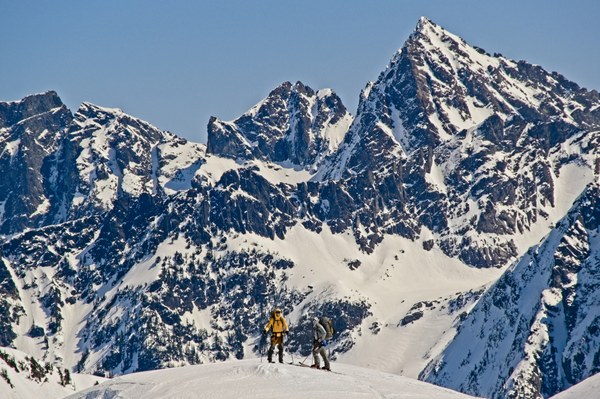 Tom, Kyle, and The Chiefs.
Tom, Kyle, and The Chiefs.
The race
We rise with the sun and climb the shadowy west slopes, still hard and icy despite warm overnight temperatures. The snow is hard enough that we need ski crampons to hold an edge as the slope steepens. While firm snow makes the climb more dangerous, it means the snow is transitioning to spring conditions. On the other side of the ridge, the sun is warming the snow, and if our timing is right, we’ll be rewarded with great skiing.
Everything is going according to plan until I lose one of my ski crampons on the final approach to the ridge. I watch it bounce, spin, and pick up speed as it careens toward the cliff band we’ve just finished climbing around. Powerful sunshine is already baking the snow, and if we wait too long it could be dangerously soft. I write the crampon off as gone before it even goes out of sight. We don’t have time for a low-probability rescue mission for an $80 piece of gear. The mountains giveth, and the mountains taketh away.
And that’s how I find myself standing on the fateful east face of Wild Goat Peak, watching as a snowball turns into a torso with the flick of a ski pole. We’re already too late.
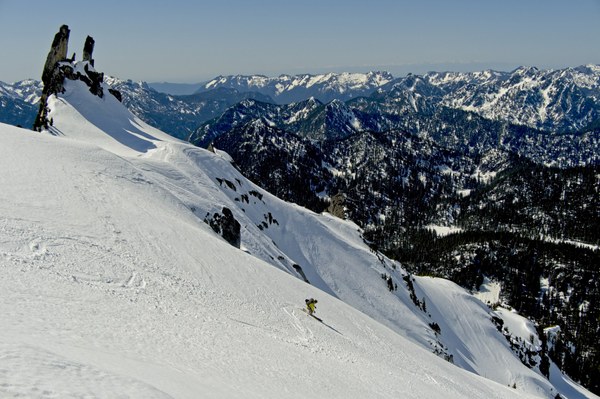 We pick our lines like the hands of a clock.
We pick our lines like the hands of a clock.
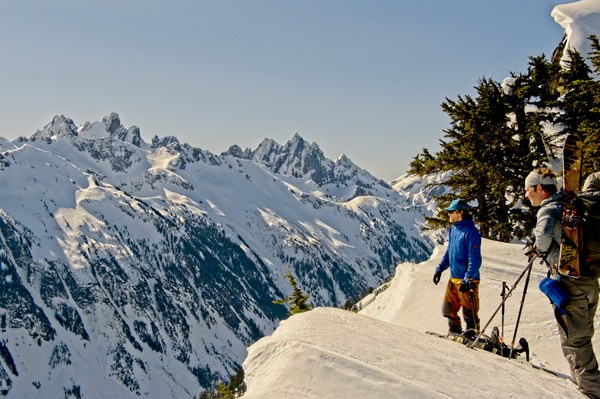 The Snoqualmie Crest taunts us before we decide to remain on Big Snow Mountain.
The Snoqualmie Crest taunts us before we decide to remain on Big Snow Mountain.
The turn
One of my favorite sayings is, “Take what the mountains give you.” The message offers important wisdom about being observant and flexible with your own plans. But I like to think about it as a two-way conversation. The mountains have a will too, with their own desires and opinions. It’s easier for me to follow nature’s directions when I imagine I’m meant to hear them. I swear the mountains are trying to trick me sometimes, but I do my best to study the terrain before going out; I watch for signs and signals while I’m in their presence, and I listen to the wisdom that is shared, even if I don’t always understand it.
If I’m lucky, the mountains speak, and I hear. If I’m even luckier, my plan gets thrown out the window and I find the path that’s meant for me.
We discuss the many alternatives to traversing the bright, mushy, and exposed east face. A safer route would be to back-track through last night’s camp. From there we could drop lower into the valleys, but lower elevations might not have re-frozen and may be worse. The hot forecast guarantees we’ll be making similar hard decisions throughout the next four days. We could race the sun to each slope, which would require an early headlamp start each morning and might not even be possible. Still, that doesn’t solve today’s problem.
Our brains churn, doing mental gymnastics to figure out a way to win a race we’ve already lost. The Snoqualmie Crest taunts us, casting huge shadows into the deep valley separating us from our destination. I turn my back to the sun in frustration and look back on Big Snow. Yesterday’s tracks trace an easy climb back up to the north shoulder. Bathed in morning light, they look like a golden staircase.
My mind wanders back to “The Centerpiece” and the pull I’d felt the day before. “We could spend five days skiing Big Snow instead,” I offer, breaking our contemplative silence.
I’m half kidding. One line isn’t enough to keep us busy for four more days, but the idea has merit. Big Snow is huge, complex, and diverse. With skiable faces on every aspect, we could pick our lines like the hands of a clock and hit each one at just the right moment as the snow ripens in the sun. Establishing a base camp there means we wouldn’t need to carry our overnight gear and food each day. We wouldn’t get to travel the famous Snoqualmie Crest, but we would enjoy its view every day. It’s the best plan anyone has put forward so far. It gives us an immediate reward and puts us closer to a viable exit. That was enough to sway the group. We turn our backs on a dream and accept the simple suggestion.
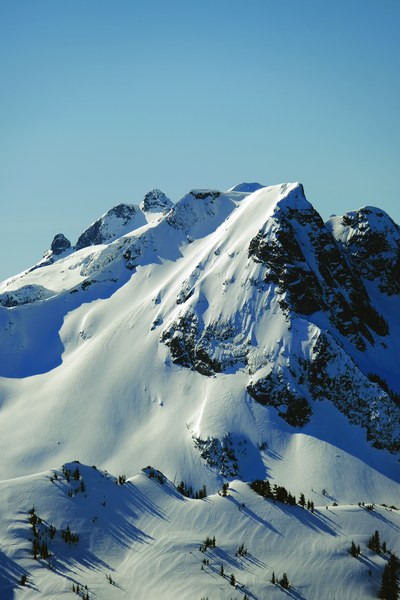 Burnt Boot: One of many dream lines added to the ever growing list.
Burnt Boot: One of many dream lines added to the ever growing list.
The dance
We retrace our previous day’s route and head directly for “The Centerpiece.” Our retreat is immediately rewarded by the miraculous recovery of my lost ski crampon. It had deftly navigated many trees and holes of the cliff band and was patiently waiting for me on the flats below. Even though I don’t need it for our climb up the golden staircase, I’m glad to have it back.
In our naivety, we drop before the sun has had a chance to say hello to this side of the peak. We scrape and skitter through an exciting but icy descent. Over time we become acquainted with the entire mountain, learning its shape and rhythm. We’re rewarded with great lines on every aspect. We grow intimately familiar with the skin track from camp to the north summit ridge, meticulously manicuring it in the soft evenings to facilitate easier travel in the crusty mornings. We tease the south faces as the sun rises and retreat quickly when the corn gives way to isothermal glop.
We repeat “The Centerpiece” a different day, this time after the sun has reached all but the deepest folds of the lower couloir. Our evenings are spent watching the mountain light up in pink and gold, highlighting the visible memories our tracks have painted as we make plans for more. We end the trip in perfect symmetry, using “The Crack” we’d spotted on our way in as our exit.
There will always be more to experience than is possible to accomplish in a single lifetime, much less five days. Amid a sea of mountains I’d dreamed of exploring, I spend an entire trip on just one. When we made the decision to turn around, I had been dubious that we would stay at Big Snow Mountain for the full five days, imagining it rather as a short-lived consolation prize. But Big Snow Mountain changed my mind.
I love backcountry skiing because of the freedom of movement it grants me through terrain. The more time I spend in the mountains, the more possibilities I see and the more difficult it gets to decide which possibilities to pursue. Spotting a good line is about reading terrain. Choosing a line is about reading conditions. In the delicate balance between freedom and constraint, it’s all too easy to let our ego be louder than the mountain’s whispers. There is art in finding joy in the conversation.
This article originally appeared in our spring 2024 issue of Mountaineer magazine. To view the original article in magazine form and read more stories from our publication, visit our magazine archive.
 Nick Aadland
Nick Aadland